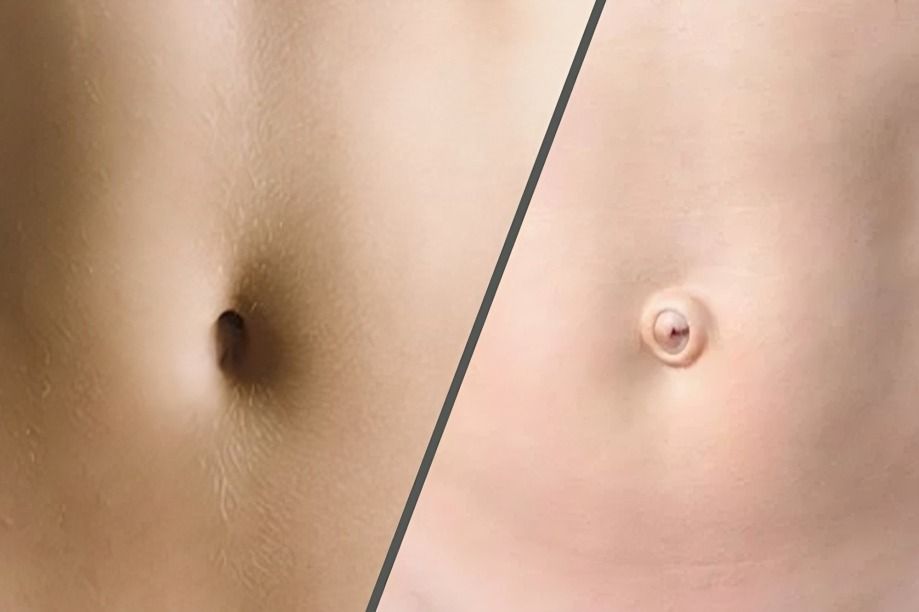
“
Our belly button, or navel, is a small yet intriguing part of our body with a rich history and many unique features. From its role before we were born to the curious ways it can collect lint, our belly button is more than just a simple spot on our tummy. Join us on a fun journey to discover some amazing and weird facts about this little body part that connects us all.1
1
”
Your belly button marks where your umbilical cord once connected you to your mom’s placenta. When the cord is cut, a small piece remains and eventually falls off, leaving a scar we call a belly button. 1
Cutting-edge technologies now allow for detailed analysis of the belly button microbiome. New genomic sequencing techniques enable scientists to study the unique microbial ecosystem in the belly button, which can reveal insights into overall health and susceptibility to diseases. 2
French surgeons, treating umbilical hernias in the 1890s, inadvertently discovered the aesthetic benefits of removing excess abdominal skin. This accidental finding marked the beginning of modern abdominoplasty. 3
Sometimes umbilical surgery leads to removal of the belly button. Supermodel Karolina Kurkova's unique appearance is due to a childhood surgery to correct an umbilical hernia. The procedure resulted in the absence of a belly button. 4
A recent study found belly buttons to be surprisingly diverse ecosystems, harbouring over 2,300 species of bacteria. Many of these microbes may be unknown to science, highlighting the hidden world existing on our bodies. 5

Did you know that belly buttons usually start as "outies"? Most of them eventually pop inward to form "innies." Only about 10% of people retain their outies!
Doctors can't determine a baby's belly button shape before birth. The shape of the belly button, whether it's an innie or outie, is naturally determined by the way the umbilical cord heals and is not something that can be chosen or predicted6
Animals born from eggs typically have smaller or no belly buttons compared to those connected to their mothers via an umbilical cord. The type of prenatal development significantly impacts the appearance of the navel. 7
About 10% of people have an outie belly button, a condition where the umbilical cord stump doesn’t heal properly. This incomplete healing results in a small, noticeable protrusion from the belly button area. 8
Seahorses give birth uniquely: the male seahorse carries eggs in a specialized brood pouch on his abdomen. When ready, he expels the baby seahorses from this pouch, not from a belly button, in a fascinating process of reproduction.9
Rarely, a condition can cause urine to leak out of the belly button. This happens when a tube called the urachus, which connects the bladder to the navel in the womb, doesn’t close properly after birth. 10
In 1951, the United States Code of Practices for Television Broadcasters prohibited women from showing their belly buttons on TV. This restriction remained in place until 1983, when the ban was finally lifted, allowing for greater freedom in television presentation.11
Although rare, belly button fungus can occur if the area is not kept clean and dry. This fungal infection is usually harmless and can be treated with antifungal creams, but it highlights the importance of good hygiene.12
Each year, thousands of people undergo belly button plastic surgery. Additionally, many of the 180,000 individuals who get tummy tucks also choose to have their belly buttons refined during the procedure, making it a common cosmetic request. 13
Everyone’s belly button is unique because of the different species of bacteria that live there. Some bacteria found in navels are so unique that they’re typically found in distant places like Japan, even if the person has never been there. 14
The belly button is naturally self-cleaning due to its depth and folds, which trap dirt and bacteria. However, regular washing is usually sufficient to maintain cleanliness and prevent any buildup or potential infections. 15
Belly buttons come in various shapes and sizes, such as round, vertical, horizontal, or even T-shaped. The shape of your navel is largely determined by how the umbilical cord was cut and how it healed. 16
Innovations in wearable tech have led to devices that use the belly button as a key site for attaching sensors, enabling continuous monitoring of metabolic functions and early detection of health issues through advanced algorithms and machine learning. 17
Just like other parts of your body, the appearance of your belly button can change with age. Skin elasticity, weight fluctuations, and muscle tone can all affect how your navel looks as you get older. 18
In some extremely rare cases, conjoined twins can be attached at the belly button. These twins share a portion of their umbilical cords creating a unique and medically complex connection between them.19


